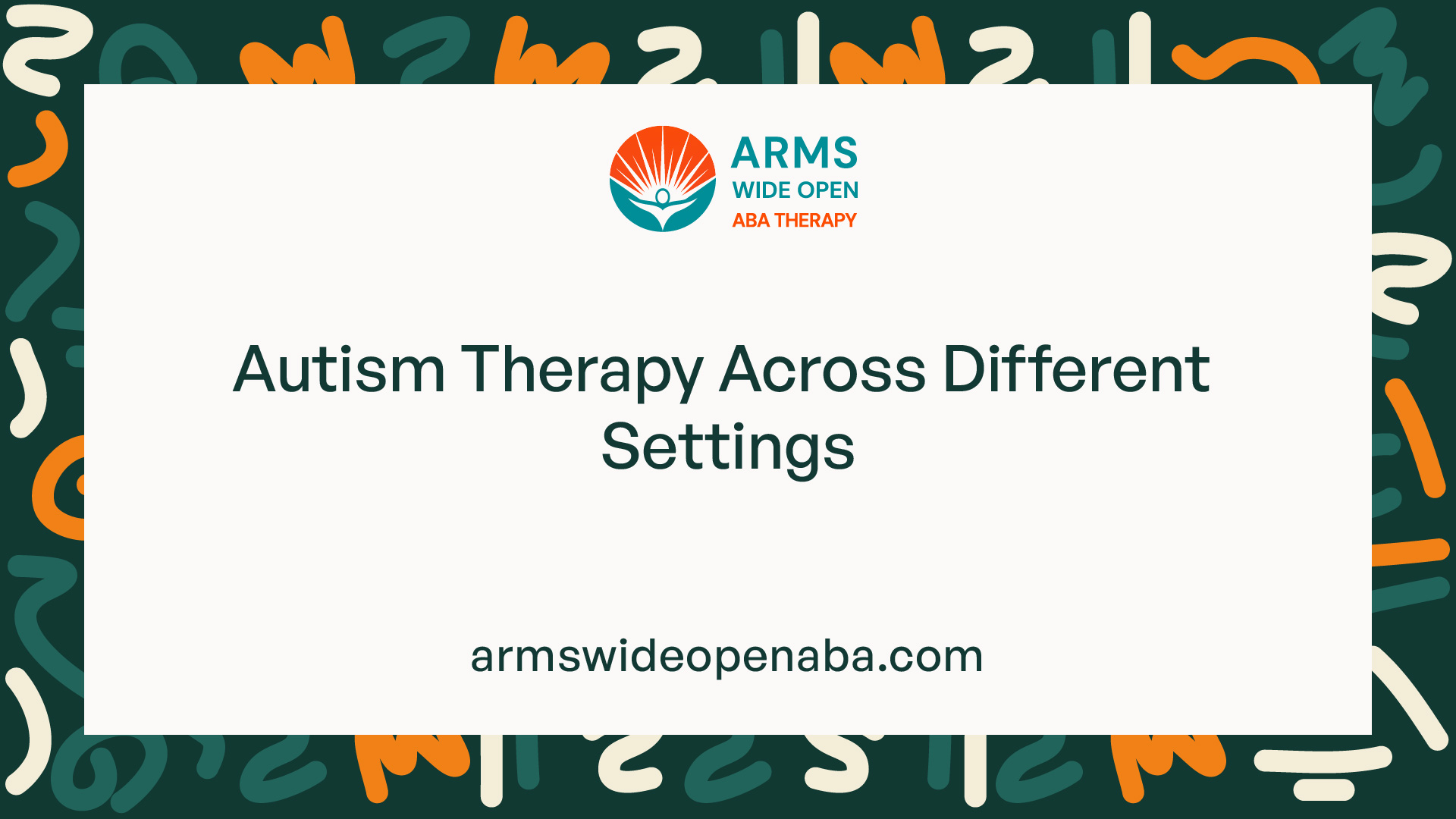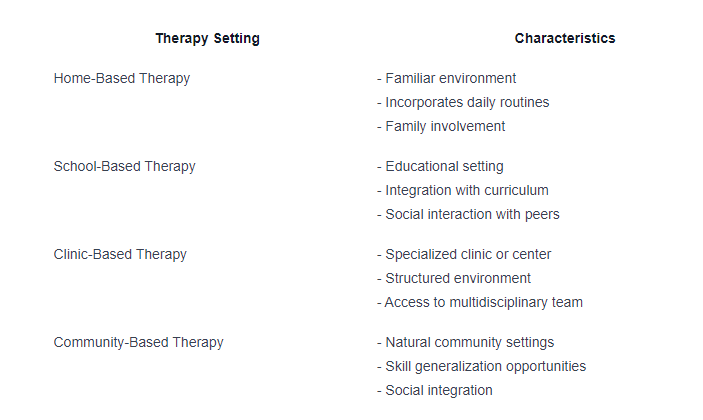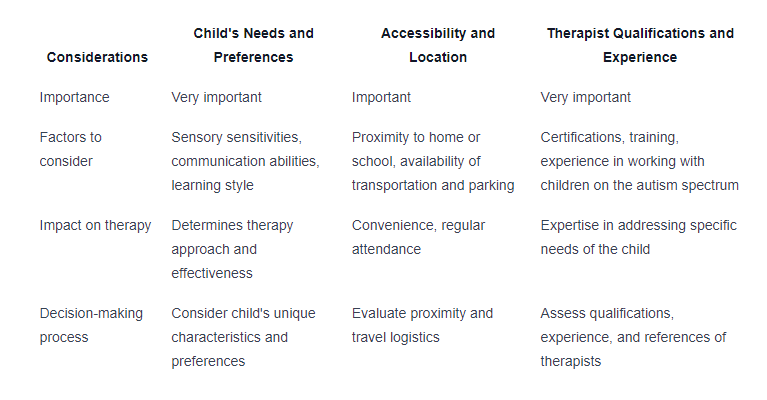Autism Therapy Across Different Settings
Explore the power of autism therapy across diverse settings. Discover the benefits and challenges for comprehensive care. Unlock potential today!

Understanding Autism Therapy
Autism therapy plays a vital role in supporting individuals with Autism Spectrum Disorder (ASD) in developing their skills, managing challenges, and improving their overall quality of life. In this section, we will explore an overview of Autism Spectrum Disorder, the importance of early intervention, and the role of therapy in autism management.

Overview of Autism Spectrum Disorder
Autism Spectrum Disorder is a neurodevelopmental disorder that affects individuals in various ways. It is characterized by challenges in social communication and interaction, as well as restricted and repetitive behaviors. The severity of symptoms can range from mild to severe, and the impact on daily functioning can vary significantly from person to person.
ASD is a lifelong condition, and early identification is crucial for accessing appropriate support and interventions. It is estimated that around 1 in 54 children in the United States are diagnosed with ASD, emphasizing the importance of understanding and addressing the needs of individuals on the spectrum.
Importance of Early Intervention
Early intervention refers to the proactive and targeted support provided to children with ASD during their early developmental years. Research has shown that early intervention can lead to significant improvements in communication, social skills, behavior, and overall cognitive development.
The brain is most malleable during the early years of life, making it a critical period for intervention. By identifying and addressing challenges early on, children with ASD have a greater opportunity to reach their full potential and improve their long-term outcomes.
Role of Therapy in Autism Management
Therapy plays a vital role in the management of Autism Spectrum Disorder. It focuses on addressing the specific challenges faced by individuals with ASD, supporting their development, and enhancing their quality of life. The goals of therapy may include improving communication skills, social interactions, adaptive behaviors, and reducing challenging behaviors.
There are various types of therapy approaches that are commonly used in autism management, including Applied Behavior Analysis (ABA), Speech Therapy, Occupational Therapy, and Social Skills Training. These therapies are evidence-based and tailored to meet the unique needs of individuals on the autism spectrum.
Therapy provides individuals with ASD the opportunity to learn and practice new skills, develop coping strategies, and enhance their overall well-being. It is a collaborative effort involving therapists, caregivers, and educators, working together to create a supportive and nurturing environment for individuals with ASD.
Understanding Autism Spectrum Disorder, recognizing the importance of early intervention, and acknowledging the role of therapy in autism management are crucial steps in unlocking the potential of individuals with ASD. By providing appropriate support and interventions, we can empower individuals on the autism spectrum to thrive and lead fulfilling lives.
Types of Therapy Settings
When it comes to autism therapy, there are various settings in which therapy can take place. Each setting has its own unique characteristics and benefits that cater to the needs of individuals with autism. Let's explore the different therapy settings commonly used:
Home-Based Therapy
Home-based therapy involves providing therapy sessions within the comfort of the child's own home. This setting allows for a familiar environment, which can be comforting for the child. Home-based therapy offers the flexibility to incorporate therapy into the child's daily routines and activities. Additionally, it provides opportunities for family involvement and participation in the therapy process.
School-Based Therapy
School-based therapy takes place in an educational setting, such as a classroom or a specialized autism program within a school. This setting allows therapists to work closely with teachers and other school staff to integrate therapy goals into the child's educational curriculum. School-based therapy provides opportunities for social interaction and inclusion with peers, helping children with autism develop their social skills in a structured environment.
Clinic-Based Therapy
Clinic-based therapy occurs in a dedicated therapy clinic or center. These clinics are equipped with specialized resources and materials to facilitate therapy sessions. Clinic-based therapy offers a controlled and structured environment, allowing therapists to focus on specific therapy goals. This setting often provides access to a multidisciplinary team of professionals, including speech therapists, occupational therapists, and behavior analysts.
Community-Based Therapy
Community-based therapy involves delivering therapy in natural community settings, such as parks, playgrounds, or recreational centers. This setting allows individuals with autism to practice and generalize their skills in real-life situations. Community-based therapy provides opportunities for social interaction with peers and promotes the integration of individuals with autism into the broader community.
To better understand the characteristics of each therapy setting, refer to the table below:

Choosing the appropriate therapy setting depends on various factors, including the child's needs and preferences, accessibility and location, and the qualifications and experience of the therapists involved. It's important to consider these factors to ensure the therapy setting aligns with the individual needs of children with autism.
Benefits of Different Therapy Settings
When it comes to autism therapy, various settings can be utilized to cater to the unique needs of each individual. Each therapy setting offers its own set of benefits, contributing to the overall progress and development of individuals with autism. In this section, we will explore the advantages of different therapy settings, including individualized attention, familiar environment, social interaction opportunities, and generalization of skills.
Individualized Attention

Individualized attention is crucial in autism therapy as it allows therapists to tailor interventions specifically to the needs of the individual. In home-based therapy, the one-on-one nature of the sessions allows for highly personalized treatment plans and focused attention on the individual's strengths and challenges. This personalized approach can facilitate faster progress and enhance the effectiveness of therapy.
Familiar Environment

The familiarity of the therapy environment can greatly impact the individual's comfort and engagement during sessions. Home-based therapy provides a familiar and comfortable setting, allowing individuals to feel at ease and more receptive to therapy interventions. This familiarity can help reduce anxiety and promote a sense of security, contributing to a positive therapy experience.
Social Interaction Opportunities

Social interaction is a critical aspect of autism therapy as it helps individuals develop and practice essential social skills. School-based therapy and community-based therapy offer ample opportunities for social interaction with peers, promoting socialization and communication skills in real-life situations. These settings provide a supportive environment where individuals can learn and practice social skills through structured activities and engagements with others.
Generalization of Skills

Generalization of skills refers to the ability to transfer learned skills from therapy settings to real-world situations. School-based therapy and community-based therapy offer greater opportunities for generalization as individuals can practice and apply skills in various contexts and environments. This helps individuals with autism generalize their newly acquired skills, promoting independence and functional application of skills beyond the therapy sessions.
Understanding the benefits of different therapy settings is essential in making informed decisions regarding the most suitable therapy approach for individuals with autism. It is important to consider individual needs, preferences, and goals when choosing the therapy setting that will best support their progress and overall development.
Considerations for Choosing a Therapy Setting
When it comes to choosing a therapy setting for autism treatment, several important considerations need to be taken into account. These considerations play a crucial role in ensuring that the therapy is effective and beneficial for the child with autism. Some key factors to consider include the child's needs and preferences, accessibility and location of the therapy setting, and the qualifications and experience of the therapists involved.
Child's Needs and Preferences
Every child with autism is unique, and their needs and preferences should be a primary consideration when choosing a therapy setting. Some children may thrive in a structured and controlled environment, while others may benefit from a more flexible and naturalistic setting. It's important to consider the child's sensory sensitivities, communication abilities, and individual learning style to determine the most suitable therapy setting.
Accessibility and Location
The accessibility and location of the therapy setting are significant factors to consider, as they can impact the child's regular attendance and participation in therapy sessions. Proximity to the child's home or school can make it easier for the child and their caregivers to travel to and from the therapy location. Additionally, considering the availability of public transportation and parking facilities can also contribute to the convenience and accessibility of the therapy setting.
Therapist Qualifications and Experience
The qualifications and experience of the therapists providing autism therapy are crucial considerations. It's important to ensure that the therapists have the appropriate certifications and training in evidence-based therapeutic approaches for autism. Additionally, their experience in working with children on the autism spectrum can provide valuable insights into their ability to address the specific needs of the child. Asking for references or seeking recommendations from other parents or professionals can help in assessing the qualifications and expertise of the therapists.
To make an informed decision, it may be helpful to create a comparison table when considering these factors:

Considering these factors can help parents and caregivers make an informed decision when choosing the most suitable therapy setting for their child with autism. It's important to weigh the benefits and limitations of each setting and prioritize the child's individual needs to ensure the therapy has a positive impact on their development and overall well-being.
Challenges in Implementing Therapy Across Settings
Implementing autism therapy across different settings can present some challenges that need to be considered. These challenges include maintaining consistency of care, transitioning between settings, and coordinating among therapists and caregivers.
Consistency of Care
One of the challenges in implementing therapy across different settings is ensuring consistency of care. When a child receives therapy in multiple settings, such as home, school, clinic, or the community, it is important to establish clear communication and coordination among all involved parties. This includes therapists, caregivers, and educators. Consistency in therapy goals, strategies, and techniques is crucial to maximize the effectiveness of the intervention and support the child's progress.
Transitioning Between Settings
Transitioning between different therapy settings can also pose challenges. Moving from one setting to another may require adjustments in routines, expectations, and environmental factors. It is important to provide adequate support to help the child transition smoothly and adapt to the new setting. This may involve collaboration between therapists, caregivers, and educators to ensure that the child's individual needs are met and that the transition process is as seamless as possible.
Coordination Among Therapists and Caregivers
Coordinating among multiple therapists and caregivers is another challenge in implementing therapy across settings. Collaboration and effective communication are essential to ensure that everyone involved in the child's care is working together towards common goals. Sharing information about the child's progress, strategies used, and any changes in therapy plans is crucial for maintaining continuity and providing comprehensive support. Regular meetings or check-ins can help facilitate coordination and ensure that all parties are on the same page.
These challenges can be overcome with proactive planning, open communication, and a collaborative approach. It is important to address these challenges to ensure that the child receives consistent, high-quality therapy across different settings and maximizes their potential for growth and development.
Sources
https://www.abtaba.com/blog/autism-therapy-in-different-settings
https://www.discoveryaba.com/aba-therapy/autism-therapy-in-different-settings
https://www.adinaaba.com/post/autism-therapy-in-different-settings
Similar articles
We’re here to help you

Our team is here to assist you in this process. Contact us for any assistance.
it’s easy to apply
Most commercial insurances accepted
Contact us for any questions regarding coverage or plans – we’ll be happy to provide you with the clearest guidance as to your best options.






.svg)





















.jpeg)


































.jpeg)




.jpeg)







.jpeg)











.jpeg)
















